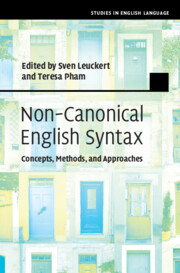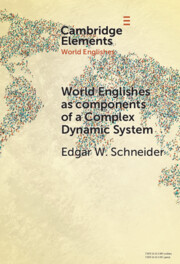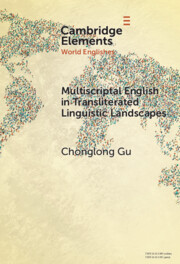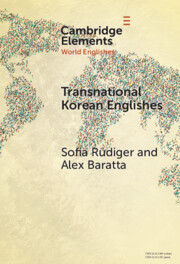Refine search
Actions for selected content:
77 results

Non-Canonical English Syntax
- Concepts, Methods, and Approaches
-
- Published online:
- 23 December 2025
- Print publication:
- 28 August 2025
-
- Book
-
- You have access
- Open access
- Export citation
Grassroots learning of English in the context of forced migration: Insights from newly arrived Congolese refugees in Norway
-
- Journal:
- English Today , First View
- Published online by Cambridge University Press:
- 20 October 2025, pp. 1-7
-
- Article
- Export citation

World Englishes as Components of a Complex Dynamic System
-
- Published online:
- 18 August 2025
- Print publication:
- 04 September 2025
-
- Element
- Export citation
English in Flux: Reframing the Arab Gulf through World Englishes - Kay Gallagher, ed.: World Englishes in the Arab Gulf States Routledge. 2025. Pp. 290. Hardback £150.00, ISBN 9781032699967; eBook £38.69 ISBN 9781032699974
-
- Journal:
- English Today , First View
- Published online by Cambridge University Press:
- 12 August 2025, pp. 1-3
-
- Article
- Export citation
Entanglements of English: Problems to be solved or realities to be acknowledged? - Jerry Won Lee and Sofia Rüdiger (eds.), Entangled Englishes (1st ed.) London & New York, Routledge, 2025. Pp. xvi+237. Paperback £39.99. ISBN: 9781032578538
-
- Journal:
- English Today , First View
- Published online by Cambridge University Press:
- 24 July 2025, pp. 1-3
-
- Article
- Export citation
Exploring L2 English pronunciation and accent aims among German high school students
-
- Journal:
- English Today , First View
- Published online by Cambridge University Press:
- 27 June 2025, pp. 1-8
-
- Article
-
- You have access
- Open access
- HTML
- Export citation
The productivity of the Complex Modifier Construction in World Englishes
-
- Journal:
- English Language & Linguistics / Volume 29 / Issue 2 / June 2025
- Published online by Cambridge University Press:
- 24 June 2025, pp. 389-410
-
- Article
-
- You have access
- Open access
- HTML
- Export citation
Legitimizing China English: A systematic approach to emerging Englishes in academic writing - Alex Baratta, Rui He and Paul Vincent Smith, Emerging Englishes: China English in Academic Writing London and New York: Routledge, 2025. Pp. vi+153. Hardback $144.00, ISBN 9781032530482; eBook $43.99, ISBN 9781003409915
-
- Journal:
- English Today , First View
- Published online by Cambridge University Press:
- 13 June 2025, pp. 1-3
-
- Article
- Export citation
The Landscape of English in Southeast Asia - Andrew J. Moody, ed., The Oxford Handbook of Southeast Asian Englishes Oxford: Oxford University Press, 2024. Pp. viii+864. Hardback £135, ISBN 9780192855282; e-book £112.50, ISBN 9780192667540
-
- Journal:
- English Today , First View
- Published online by Cambridge University Press:
- 13 June 2025, pp. 1-3
-
- Article
- Export citation
7 - Influencing People Around the Globe
- from II - Persuasion and (New) Contexts of Use
-
-
- Book:
- Manipulation, Influence and Deception
- Published online:
- 10 June 2025
- Print publication:
- 24 April 2025, pp 135-154
-
- Chapter
- Export citation
Decoding Bollywood: why Hindi–English code-switching and standard English outrank Indian English
-
- Journal:
- English Language & Linguistics / Volume 28 / Issue 4 / December 2024
- Published online by Cambridge University Press:
- 25 March 2025, pp. 683-708
-
- Article
-
- You have access
- Open access
- HTML
- Export citation
Fascination with English in South Korea - Jieun Kiaer and Hyejeong Ahn, Emergence of Korean English: How Korea's Dynamic English Is Born Abingdon and New York: Routledge, 2024. Pp. xi+180. Hardback £108.00, ISBN 9781032257709, e-book £31.99, ISBN 9781003284956
-
- Journal:
- English Today , First View
- Published online by Cambridge University Press:
- 18 March 2025, pp. 1-2
-
- Article
- Export citation
A peculiar pair of festschrifts - Aloysius Ngefac, Hans–Georg Wolf and Thomas Hoffmann (eds.), World Englishes and Creole Languages Today, Vol. I: The Schneiderian Thinking and Beyond Muenchen: Lincom, 2022. Pp. 246. Hardback €178,00, ISBN: 9783 969390917. - Aloysius Ngefac, Hans–Georg Wolf and Thomas Hoffmann (eds.), World Englishes and Creole Languages Today, Vol. II: The Bobdian Thinking and Beyond Muenchen: Lincom, 2022. Pp. 270. Hardback €184,00, ISBN: 9783 969390924.
-
- Journal:
- English Today , First View
- Published online by Cambridge University Press:
- 04 March 2025, pp. 1-2
-
- Article
- Export citation
A unified perspective on the status of English in the Nordic countries - Elizabeth Peterson and Kristy Beers Fägersten, eds., English in the Nordic Countries: Connections, Tensions, and Everyday Realities New York and Oxon: Routledge, 2024. Pp. xvi+244. Paperback £29.59, ISBN: 978-1-03-222467-1
-
- Journal:
- English Today / Volume 41 / Issue 2 / June 2025
- Published online by Cambridge University Press:
- 24 February 2025, pp. 146-148
- Print publication:
- June 2025
-
- Article
- Export citation
Multilingual English teachers in Asian Expanding Circle ELT: Multilingual English teachers in Asian Expanding Circle ELT: A literature review
-
- Journal:
- English Today / Volume 41 / Issue 1 / March 2025
- Published online by Cambridge University Press:
- 17 February 2025, pp. 52-59
- Print publication:
- March 2025
-
- Article
-
- You have access
- Open access
- HTML
- Export citation

Multiscriptal English in Transliterated Linguistic Landscapes
-
- Published online:
- 07 February 2025
- Print publication:
- 13 February 2025
-
- Element
- Export citation

Transnational Korean Englishes
-
- Published online:
- 06 February 2025
- Print publication:
- 06 February 2025
-
- Element
- Export citation
Comparative variation analysis at cross roads: perspectives and methods - Benedikt Szmrecsanyi and Jason Grafmiller, Comparative Variation Analysis: Grammatical Alternations in World Englishes Cambridge; New York, NY: Cambridge University Press, 2023. Pp. xvii+218. Hardback $125, ISBN: 9781108491563
-
- Journal:
- English Today / Volume 41 / Issue 1 / March 2025
- Published online by Cambridge University Press:
- 30 January 2025, pp. 68-70
- Print publication:
- March 2025
-
- Article
- Export citation
Beyond the ‘standard’ - Bertus van Rooy, World Englishes: The Local Lives of a Global Language. 1st ed. Edinburgh: Edinburgh University Press, 2024. Pp viii+230. Paperback, £24.99. ISBN: 9781474486309.
-
- Journal:
- English Today / Volume 41 / Issue 1 / March 2025
- Published online by Cambridge University Press:
- 23 January 2025, pp. 65-67
- Print publication:
- March 2025
-
- Article
- Export citation
Improving EFL learners’ self-confidence in English-speaking performance with World Englishes teaching: A tentative study from China
-
- Journal:
- English Today / Volume 40 / Issue 4 / December 2024
- Published online by Cambridge University Press:
- 20 December 2024, pp. 283-293
- Print publication:
- December 2024
-
- Article
- Export citation
